Juno at Jupiter, mission events as they unfold |

  |
Juno at Jupiter, mission events as they unfold |
 Jul 25 2016, 07:19 PM Jul 25 2016, 07:19 PM
Post
#46
|
|
 Junior Member   Group: Members Posts: 54 Joined: 7-July 16 From: Austin, Texas Member No.: 7991 |
Rendition of Jupiter approach movies completed. Edit: Added zip-files (about 800 MB) with the frames used for the animations. Nice work on the movie! It will be great to have your process all set up when the more detailed images start coming back. Did you have to do much in the way of alignment and stabilization after chopping up the images? |
|
|
|
 Jul 25 2016, 08:08 PM Jul 25 2016, 08:08 PM
Post
#47
|
|
|
Member    Group: Members Posts: 910 Joined: 4-September 06 From: Boston Member No.: 1102 |
Gerald,
Very nice work. Question, where does the Blue on top and Red on bottom artifact come from. Strangely, the moon shadow has the blue below the red image what's going on? -------------------- |
|
|
|
 Jul 25 2016, 08:39 PM Jul 25 2016, 08:39 PM
Post
#48
|
|
|
Senior Member     Group: Members Posts: 2346 Joined: 7-December 12 Member No.: 6780 |
@Brian Burns: Thanks! I hope so, too.
I'm simulating the behaviour of the camera as good as I can, and calc back from an output pixel position to pixel positions in the EDRs to obtain color information for the output pixel. For the sequence I've moved the green channel of Jupiter's centroid to the center of the respective image to obtain alignment along the sequence. @Floyd: Thank you! My camera simulation is not yet quite perfect; I needed to make a decision between investing more time to narrow down the parameters, or releasing images with imperfect RGB alignment. So I get some RGB misalignment. The apparent exchanged alignment error is essentialy the same misalignment; the difference between the two is dark shadow on bright background vs. bright object on dark background; this causes the observed effect. My schedule was completing an RMS minimization for the parameters somewhere between end of July and end of August, with end of October as deadline, when the regular science mission begins. But I thought releasing processed images of imperfect quality is better than releasing no processed images. With a delay of several months I may be able to pin down the camera parameters to the best possible within a given family of camera models. |
|
|
|
 Jul 25 2016, 09:25 PM Jul 25 2016, 09:25 PM
Post
#49
|
|
|
Senior Member     Group: Members Posts: 2511 Joined: 13-September 05 Member No.: 497 |
I'm simulating the behaviour of the camera as good as I can, and calc back from an output pixel position to pixel positions in the EDRs to obtain color information for the output pixel. Despite the color misalignment, considering the method it's quite impressive and indicative of the amount of work you've done that this product is as well-aligned as it is. I made the decision with my movie processing to not try to model the camera at all, which actually works better in most cases while completely choking on images where the planet landed on framelet boundaries -- those had to be fixed by hand. Are you using the C kernel data or coming up with some independent estimate of s/c orientation based only on camera images? BTW, there is a large high-latitude shadow of Ganymede in frame 1196-1199 or so. -------------------- Disclaimer: This post is based on public information only. Any opinions are my own.
|
|
|
|
 Jul 25 2016, 09:49 PM Jul 25 2016, 09:49 PM
Post
#50
|
|
|
Senior Member     Group: Members Posts: 2346 Joined: 7-December 12 Member No.: 6780 |
Thanks, well I had almost three years time to experiment with efb01.
For the distant Jupiter image I'm working completely different from an initial intuitive reality regarding the 3d scenario. In this case, it's sufficient instead to assume Juno staying in the center of a hollow sphere with a large radius, and all objects placed on the surface of this sphere. I've used a by-hand approximation method to find Juno's rotation in terms of interframe delay, essentially a bisection method, working best for swathes where you get Jupiter at the start and at the end of the swath. But since I've used only a very small number of test images, and since there are other uncertain camera parameters, the value isn't optimized over the whole data set. This approach won't work with Jupiter close-by. Then trajectory and Jupiter's shape and rotation need to be modeled. But with the latter approach the transition between Jupiter's shape and infinity gets somewhat tricky. Edit: Yes, I see a clear shadow in 1196-1199. I'll post the cropped images later. |
|
|
|
 Jul 25 2016, 10:51 PM Jul 25 2016, 10:51 PM
Post
#51
|
|
|
Senior Member     Group: Members Posts: 2346 Joined: 7-December 12 Member No.: 6780 |
Animated gif of 4 images showing Ganymede's shadow on Jupiter:
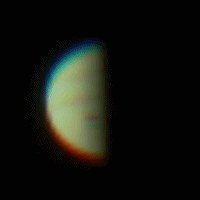 Still frames: 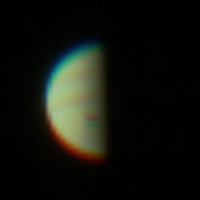 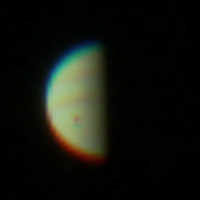 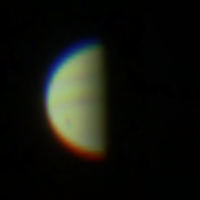 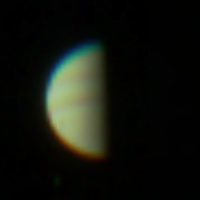 Sorry for the larger RGB misalignment in these images. But intersting is image 1196, where Ganymede's shadow is so close to the terminator, that it's highly elliptical. I'll prepare a graphics which shows the connection to Ganymede. |
|
|
|
 Jul 25 2016, 11:21 PM Jul 25 2016, 11:21 PM
Post
#52
|
|
|
Senior Member     Group: Members Posts: 2346 Joined: 7-December 12 Member No.: 6780 |
|
|
|
|
 Jul 27 2016, 11:09 AM Jul 27 2016, 11:09 AM
Post
#53
|
||
|
Senior Member     Group: Members Posts: 2346 Joined: 7-December 12 Member No.: 6780 |
To find out the limiting magnitude for stars and possibly moons for JunoCam's TDI 4 images, I've stacked (summed two averages of 16 images in this case) 32 log-stretched processed Jupiter Approach images, and stretched the result roughly with a square root function after subtracting some constant bias. The limiting magnitude seems to be near vmag 1.0. Rigel, Betelgeuse, and Aldebaran can reproducibly be processed out. Other stars of Orion or Taurus seem to be invisible or ambiguous at least.
But I hesitated to post the image yesterday as it has been, since there are several properties and features to be explained: - The image is heavily stretched, and therefore shows much image noise. - The stars look almost white. In smaller stacks, Betelgeuse and Aldebaran look reddish, as to be expected. - The vertical stripes are processed compression artifacts. - Narrow vertical lines, interrupted or not, are mostly summed hot pixels. - Faint objects appear to induce a darker environment in lossy DCT (compression) blocks. - Jupiter's Galilean moons average almost away due to their motion. Only their dark compression artifacts remain well-visible in the stacked image. - There is a horizontal brightish stripe through Jupiter, and extending horizontally across the image. This is likely explainable as subtle lense flare, although I didn't find a documentation about the appearance of JunoCam's lense flare. Near Jupiter, the averaged moons might add some brightness. I cannot disambiguate, whether a ring adds visible brightness. - There is a vertical brightish feature north and south of Jupiter (south is up). This seems to be independent of the position of the moons, hence cannot be explained away by a lack of dark compression blocks. Thus far, I can't rule out a lossy image compession side effect of Jupiter, lense flare, and some real feature like hot hydrogen. But the latter is no way evident from the image. |
|
|
|
||
 Jul 27 2016, 06:11 PM Jul 27 2016, 06:11 PM
Post
#54
|
|
|
Member    Group: Members Posts: 154 Joined: 21-April 05 From: Rochester, New York, USA Member No.: 336 |
moderators - might be good to have a separate thread specific to Junocam image processing?
Mod- Maybe later. For now, Junocam imagery will likely be the main concern of this thread anyhow. Let's see how the mission unfolds. |
|
|
|
 Jul 29 2016, 03:29 PM Jul 29 2016, 03:29 PM
Post
#55
|
|
 Administrator     Group: Admin Posts: 5172 Joined: 4-August 05 From: Pasadena, CA, USA, Earth Member No.: 454 |
Thanks, Gerald, for posting all your processed images. I made one of my usual indexes to all the data using your thumbnails. Makes it easy to spot the shadow crossings
https://planetary.s3.amazonaws.com/data/jun...m_approach.html -------------------- My website - My Patreon - @elakdawalla on Twitter - Please support unmannedspaceflight.com by donating here.
|
|
|
|
 Jul 29 2016, 04:41 PM Jul 29 2016, 04:41 PM
Post
#56
|
|
|
Senior Member     Group: Members Posts: 2346 Joined: 7-December 12 Member No.: 6780 |
Thanks Emily, for taking this part! You're doing a great job, and you deserve well some vacation.
I'm currently working on a way to improve RGB registering on the basis of improved camera parameters, in order to be ready for delivering the necessary quality, when it's really needed near Jupiter conjunction. Since this implies quite some programming and number crunching, this always takes time. |
|
|
|
 Jul 29 2016, 05:00 PM Jul 29 2016, 05:00 PM
Post
#57
|
|
|
Senior Member     Group: Members Posts: 2511 Joined: 13-September 05 Member No.: 497 |
I made one of my usual indexes to all the data using your thumbnails. One minor nit: two of the last three images (1586 and 1588) were taken with TDI 1. It may be worth pointing out that south is up in all of these. Our final processed images are rotated 180 degrees. I packaged up our processed images last week, but getting those files up on missionjuno is still in work. Maybe next week they will show up. -------------------- Disclaimer: This post is based on public information only. Any opinions are my own.
|
|
|
|
 Jul 31 2016, 12:39 AM Jul 31 2016, 12:39 AM
Post
#58
|
|||
|
Senior Member     Group: Members Posts: 2346 Joined: 7-December 12 Member No.: 6780 |
Despite the color misalignment... this product is as well-aligned as it is. I made the decision with my movie processing to not try to model the camera at all, which actually works better in most cases... A still rudimentary analysis of the color misalignment helped already to improve the alignment considerably. Thus far I've just rendered a few hundred images with the refined parameters. Despite not yet being the best possible parameters in the sense of an overall optimization, the results already look good. Here an arbitrarily chosen cropped example, previous vs. refined version: Respective parameters of the previous and the refined version:  JNCE_2016178_00C1310_V01_proc007.BMP.LBL ( 1.21K )
Number of downloads: 238
JNCE_2016178_00C1310_V01_proc007.BMP.LBL ( 1.21K )
Number of downloads: 238 JNCE_2016178_00C1310_V01_proc012.BMP.LBL ( 1.21K )
Number of downloads: 240
JNCE_2016178_00C1310_V01_proc012.BMP.LBL ( 1.21K )
Number of downloads: 240I've used image 196 to find a good x/z pinhole scale together with an according y-position of the optical axis, and image 200 to re-adjust Juno's rotation (angular velocity) in terms of interframe delay. For image 196, I got a residual mismatch of the blue channel relative to red and green of about 1/8 raw pixel, while red and green matched rather accurate in the 1/100 raw pixel range. - I've defined mismatches via centroid displacements between color channels. For image 200, I've refined the angular velocity parameter just visually. |
||
|
|
|||
 Jul 31 2016, 09:14 AM Jul 31 2016, 09:14 AM
Post
#59
|
||
 Member    Group: Members Posts: 238 Joined: 15-January 13 Member No.: 6842 |
I took the liberty of colour-balancing Gerald's new image, if that's ok. Jupiter looks so beautiful!
By the way, is there a way to import Juno into Stellarium? It would be great to hitch a "ride" on the spacecraft that way. -------------------- Curiosity rover panoramas: http://www.facebook.com/CuriosityRoverPanoramas
My Photosynth panoramas: http://photosynth.net/userprofilepage.aspx...;content=Synths |
|
|
|
||
 Jul 31 2016, 11:33 AM Jul 31 2016, 11:33 AM
Post
#60
|
|||||
|
Senior Member     Group: Members Posts: 2346 Joined: 7-December 12 Member No.: 6780 |
The success of JunoCam outreach depends largely on "the public" providing creative image products. So yes, it's of course welcome to create derived products of my images.
Here an early attempt to enhance Jupiter and its satellites (together with some hot pixels) with one non-monotonic stretching function: -------- I see a strong hint, that the ratio between Juno's rotation period and JunoCam's interframe delay changed at some point of the Jupiter approach. To get to this conclusion, I've looked at swathes which got Jupiter into the field of view near start and stop time of the swath. Here an image early in the approach phase (image 200), processed by assuming 80.943 exposures per rotation: It looks well-registered. Here image 1330, late in the approach phase, with the same assumption: It looks slightly misaligned. By changing the assumption to 80.956 exposures per rotation, the result looks good: The change would correspond to either a change of Juno's rotation period of about 5 ms, or equivalently to a change of JunoCam's interframe delay of about 60 μs. According parameter files:  JNCE_2016164_00C200_V01_proc012_80.943.BMP.LBL ( 1.21K )
Number of downloads: 211
JNCE_2016164_00C200_V01_proc012_80.943.BMP.LBL ( 1.21K )
Number of downloads: 211 JNCE_2016178_00C1330_V01_proc012_80.943.BMP.LBL ( 1.21K )
Number of downloads: 213
JNCE_2016178_00C1330_V01_proc012_80.943.BMP.LBL ( 1.21K )
Number of downloads: 213 JNCE_2016178_00C1330_V01_proc012_80.956.BMP.LBL ( 1.21K )
Number of downloads: 206
JNCE_2016178_00C1330_V01_proc012_80.956.BMP.LBL ( 1.21K )
Number of downloads: 206 |
||||
|
|
|||||
  |

|
Lo-Fi Version | Time is now: 29th April 2024 - 10:21 AM |
|
RULES AND GUIDELINES Please read the Forum Rules and Guidelines before posting. IMAGE COPYRIGHT |
OPINIONS AND MODERATION Opinions expressed on UnmannedSpaceflight.com are those of the individual posters and do not necessarily reflect the opinions of UnmannedSpaceflight.com or The Planetary Society. The all-volunteer UnmannedSpaceflight.com moderation team is wholly independent of The Planetary Society. The Planetary Society has no influence over decisions made by the UnmannedSpaceflight.com moderators. |
SUPPORT THE FORUM Unmannedspaceflight.com is funded by the Planetary Society. Please consider supporting our work and many other projects by donating to the Society or becoming a member. |

|